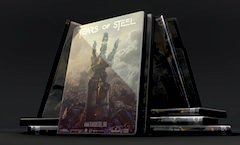Here’s a first tutorial/log about environment modelling and texturing.
It’s about materials in cycles, shaders-preset nodegroups in particular , next videos will be more strictly about modelling and texturing, but i’m starting with this because .. it’s just such a cool topic: while setting up textures for the dome it was necessary to organize them in a way that lighting and shading artists could make sense of it, tweak it or rearrange the material for the final shot .
So i started using nodegroups for organization… But it’s more than just keeping the node-tree tidy and readable, it speeds up material creation, keeps things consistent and allows to refactor and do quick ‘global’ changes on materials.
It’s also a good starting point to just discuss best-practices for texturing and shading in Cycles, so i’m looking forward to comments, and the presets you see in this video could be expanded with more types and variants (there’s quite a few threads on BlenderArtists i need to dig through :)
More to come, I’m still tuning the audio recording quality (I removed noise and normalized in Audacity, but my new soundcard is still misbehaving. It’s also tricky to find the right balance between doing many takes and editing more, to make the speech more fluid)


awesome !!!!!! incredible helpful !
can you post a screenshot from the node-setup as an image ?
A .blend of the material library would be better actually. =)
Great work! Very informative and useful, thanks.
Nate Wiebe: that’s not that difficult to redo the nodes from the video examples.
Agreed, but there were nodes or textures that weren’t shown.
the full env. materials library will take 2-3 more videos : one for blended box mapping textures (framed in grey in video) 1 for the 3layers stencil based on dirtmaps (yellow frame) and 1 for a sample material creation.
thanks!
Glad you like the materials and the video.
The full library (shader presets, blending , textures) will be included with project Mango files (on the DVD)
Btw, The library could still expand during the project, and these presets can be tweaked to personal prefs. and workflows.
Anyway, here’s a sample :
http://www.pasteall.org/blend/14968
It’s the main type (dif+glossy) , good to use directly or to take apart and tweak (let me know if you do and find reasons to setup stuff differently , like the fresnell controls or else..)
Have fun :D
Haven’t watched the video yet, but is there a way to save node/node groups for use in other blender projects?
one way is to make a blend file with your nodegroups and then use file->link in your project and get the nodegroups from that blend file.
yes, it’s mentioned briefly that the library file is used linking the nodegroups to other scenes.
But watch out that the linking tree gets complicate very quick.
We had a few broken materials while i was there : when you start linking into a final scene objects with materials from various sources plus the nodegroups from a library …
The linking-tree gets complicate very soon , and it’s not that easy to tell if you’re creating a messy/looping link tree or if it’s a bug and should have been working.
Infact, an option Campbell mentioned is having a python script generate such nodegroups with 1 click but locally , as a local item inside your scene.
(he said that presets for Cycles nodes have been discussed/planned since indeed materials are split into their base elements -which is great flexibility- but most users will want a more pre-assembled form )
Very helpful. I have always used an add shader to combine my glossy and diffuse. The mix shader makes more sense.
Add shader is an option , but ‘mix’ is the default choice to respect energy conservation ( a material should not bounce back more light than it receives )
Adding reflections on top might be easier and quicker to setup at first and good for strong reflective coating and non-physical setups , but then you don’t know really if the material becomes an emitter which might mess up GI results.
Great nodes!. Only one question. In the last node group, the Glossy shader color for mirror effect is pure white (1,1,1)? Thanks
yes, it’s pure white.
But now that you mention it : there’s a rule about only using off-white for base color in GI shaders : if you use 1,1,1-white the ray won’t loose any energy and bounce around too much (too long) leading to incorrect decay and longer rendertimes.
That’s true for diffuse (because you generally use mostly diffuse materials and maybe more than a few bounces for diffuse )
For glossy you’d have to be using lots of bounces and very strong glossy coat for that to be a problem .. but maybe could generate fireflies too , so maybe switching it to a 90-95% white would be good.
“…maybe could generate fireflies too , so maybe switching it to a 90-95% white would be good.”
Yes, this are the informations we need more I think, coming from people who spent lot of time working with Cycle materials in a production environment.
Thanks also for the blend. :)